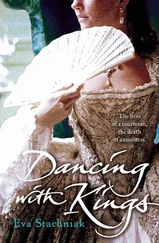Eleanor Herman
SEX WITH KINGS
500 Years of Adultery, Power, Rivalry, and Revenge
To my mother, Louise, in Heaven
When the destiny of a nation is in a woman’s bedroom, the best place for the historian is in the antechamber.
—CHARLES-AUGUSTIN SAINTE-BEUVE
IF PROSTITUTION IS THE WORLD’S OLDEST PROFESSION, THEN the finer art of being a mistress must be the second oldest.
When we imagine the finest mistress of all—she who is fit for a king—we see a hazy, shimmering image of a woman whose hands caress and mold history. She stands, for the most part, in the shadows of a world where the spotlight shines solely on men bludgeoning history into shape. Now and then we hear the rustling of a silk skirt, or hear her musical laughter echoing from behind the throne.
The rise of the royal mistress in European courts was sudden, springing up from departing medieval mists. For a thousand years after the fall of Rome, royal sin was hidden in the thick hangings of a four-poster bed and then lamented in the stuffy darkness of the confessional. The powerful Catholic Church cast a jaded eye on adultery, and the jezebels of the court were kept firmly in the background.
Sometimes a woman’s first name was linked to a feudal monarch, a Maude or a Blanche, and nothing else is known. Numerous royal bastards, acknowledged by kings, seemed to sprout from thin air, and we can only assume they had mothers. This near-total lack of information of royal love affairs derived not only from church demands for discretion. Illiteracy reigned just as surely as the monarchs themselves, monarchs who were for the most part unable to sign their names.
It is only because of her avarice that we know anything about the English medieval mistress Alice Perrers. The courtesan of Edward III (1312–1377), greedy Alice used her position during the last decade of the old king’s life to rape the treasury, becoming one of the largest landowners in England. Deftly exploiting Edward’s senility, she convinced him to buy her the same jewels over and over again, each time pocketing the cash he gave her to procure them. As if this weren’t enough, sitting at her royal lover’s deathbed, Alice pried valuable rings from his stiffening fingers and ran off with them. A scandalized Parliament confiscated her estates in seventeen counties, her jewels (including 21,868 pearls), and other gifts from the king. Litigious Alice spent the rest of her life in court trying to get them back, as attested by treasury records, parliamentary decrees, and lawsuits.
Where the English were clumsy, the French were nimble. Some seventy years after the embarrassing Alice Perrers, the prototypical royal mistress rose in golden glory like a phoenix from the ashes of dark centuries. Ably wielding political influence over country and king, Agnes Sorel was—naturally—a Frenchwoman at the French court. Graceful Agnes succeeded in rousing Charles VII (1403–1461) from his debilitating apathy to rally his troops and drive English invaders from French soil. Charles, a sad clown-faced, knock-kneed little man lost in his thickly padded tunics, made a poor king before Agnes, and returned to being a poor king after her.
The earliest surviving portrait of a royal mistress is of Agnes, painted in 1449, a time when secular portraits were not yet common, and many of the rich and famous still bribed church artists to paint their faces on saints. Oddly enough, Agnes was painted as the Virgin Mary in a two-part church panel. In her panel, now in the Koninklijk Museum of Antwerp, Agnes, wearing a crown and an ermine cape, reveals a ripe plump breast to the baby Jesus, who seems completely uninterested and looks away. The other panel, however, now in the Staatliche Museum of Berlin, shows a good friend of hers, Etienne Chevalier, on his knees in worshipful devotion. This diptych of the king’s mistress, mother of his illegitimate children, depicted as the Mother of God must have shocked the devout, their shock compounded by the vision of her friend worshiping her exposed breast.
It is probably no coincidence that shortly after the painting was completed, the powers of heaven sent the Grim Reaper to harvest Agnes. At the age of about forty, after fifteen years as the king’s lover, friend, and counselor, Agnes lay dying in childbirth. Perhaps she was looking back from a grander place when she saw her vanquished body and said softly, “It is a little thing and soiled and smelling of our frailty.” 1She closed her eyes. The grief-stricken king made her a posthumous duchess and buried her in splendor.
Our knowledge of royal mistresses increases exponentially with the advent of the sixteenth century. The flowering of thought known as the Renaissance brought fresh air to a stultified Europe. Suddenly ships sailed the seven seas, bringing back undreamed-of riches. Monasteries were searched for moldering manuscripts bearing the wisdom of ancient pagan sages. Societies which had worshiped at the feet of a stone Virgin for a thousand years suddenly frolicked before a curvaceous statue of Venus. In this process the Vatican lost its key to the lockbox of all knowledge; its ironclad grip over morals and manners was substantially weakened—even in nations that remained Catholic after the Reformation.
The invention of the printing press triggered an explosion of literacy among the nobility. Letter writing became a favorite pastime for courtiers eager to indulge rustic relatives with juicy court gossip. From them we hear of the queen’s tears, the mistress’s temper tantrums, and the king’s insatiable lust. Madame de Maintenon, the final favorite and morganatic wife of Louis XIV (1638–1715), wrote more than ninety thousand letters in her lifetime. Louis’s sister-in-law Elizabeth Charlotte, duchesse d’Orléans, wrote sixty thousand letters about life at the court of Versailles over a fifty-year period. Madame de Sévigné, who knew Louis XIV’s mistresses personally, wrote three times a week for twenty-five years to her beloved daughter tucked away in Provence. Some of the personal correspondence of kings and their mistresses themselves has survived fire, flood, worms, and deliberate destruction, and a portion of it deals with the romantic side of life.
Additionally, ambassadorial reports provide detailed views into court life. In an era when a king’s whim meant peace or war, feast or famine, no royal detail was considered insignificant. Some official dispatches discussed the king’s bowel movements. Louis XIV, knowing that the many mistresses of Charles II (1630–1685) had great influence over him, instructed his ambassadors to England to send “detailed reports of all that goes on in the Court of Great Britain and particularly in the privy part .” 2Many of these titillating dispatches have survived.
Diaries became the fashion, giving eyewitness accounts of royal intrigues. One of the best-known diarists was Samuel Pepys, who worked in a high-level position in the English Naval Office in the 1660s and had a lascivious fascination with Charles II’s mistresses. He reported seeing them in the park and at the theater, compared their beauty, described their clothing, and made love to them in his dreams. He gleefully wrote that he had kissed Nell Gwynn after her play, and that the sight of Lady Castlemaine’s rich undergarments hanging on a clothesline proved very beneficial indeed.
Memoirs became popular, though they must be read with care and compared with other documents of the period. Written with an aim of publication, many memoirs had the dual purpose of self-vindication and finger-pointing. Shortly before her death in 1615, Queen Marguerite of France wrote her memoirs to provide herself with a virtue as crisply white as parchment, throwing in numerous stories of her husband’s unseemly behavior with mistresses, though leaving out her own unseemly behavior with lovers. The vengeful duc de Saint-Simon, who left Versailles a disappointed courtier in 1722, stubbornly scratched his quill across forty volumes of memoirs, his ink mixed with hearty doses of venom.
Читать дальше












